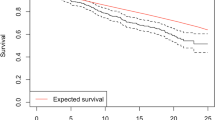Abstract
Introduction
Down syndrome is the most common chromosomal abnormality associated with intellectual impairments. Unexpected deaths are common with this disease. There are certain difficulties in clarifying the cause of death because the manifestations may be quite diverse and involve many organ systems. Atlantoaxial subluxation is a dangerous complication of Down syndrome, as it may lead to cervical cord-medullary compression.
Case presentation
Herein, we present a case of Down syndrome in a patient who completely recovered from cardiac arrest due to atlantoaxial subluxation. The neck was immobilized during post-cardiac arrest care, and the patient underwent surgery after 14 days. The patient could walk independently and was discharged 3 months later. At the last follow-up 5 years after surgery, the patient’s general condition was good.
Discussion
Physicians should be aware that atlantoaxial instability can cause cardiac arrest in patients with genetic syndromes.





Similar content being viewed by others
Data availability
All data supporting the findings of this study are available within the article.
References
Bull MJ. Down syndrome. N Engl J Med. 2020;382:2344–52. https://doi.org/10.1056/NEJMra1706537.
Hankinson TC, Anderson RC. Craniovertebral junction abnormalities in Down syndrome. Neurosurgery. 2010;66:A32–8. https://doi.org/10.1227/01.NEU.0000365803.22786.F0.
Onodera R, Sakamoto R, Taniguchi Y, Hirai S, Matsubayashi Y, Kato S, et al. Congenital atlanto-occipital dislocation in a patient with Down syndrome: a case report. Skeletal Radiol. 2023;52:1785–9. https://doi.org/10.1007/s00256-023-04297-5.
Byard RW. Forensic issues in Down syndrome fatalities. J Forensic Leg Med. 2007;14:475–81. https://doi.org/10.1016/j.jflm.2007.01.001.
Scorza CA, Scorza FA, Arida RM, Cavalheiro EA. Sudden unexpected death in people with down syndrome and epilepsy: another piece in this complicated puzzle. Clinics. 2011;66:719–20. https://doi.org/10.1590/s1807-59322011000500001.
Lehmann KG, Lane JG, Piepmeier JM, Batsford WP. Cardiovascular abnormalities accompanying acute spinal cord injury in humans: incidence, time course and severity. J Am Coll Cardiol. 1987;10:46–52. https://doi.org/10.1016/s0735-1097(87)80158-4.
Teasell RW, Arnold JM, Krassioukov A, Delaney GA. Cardiovascular consequences of loss of supraspinal control of the sympathetic nervous system after spinal cord injury. Arch Phys Med Rehabil. 2000;81:506–16. https://doi.org/10.1053/mr.2000.3848.
McKay SD, Al-Omari A, Tomlinson LA, Dormans JP. Review of cervical spine anomalies in genetic syndromes. Spine. 2012;37:E269–77. https://doi.org/10.1097/BRS.0b013e31823b3ded.
Shibao Y, Koda M, Nakayama K, Asada T, Sato K, Kono M, et al. A case of cardiac arrest during C1 laminectomy for irreducible atlantoaxial subluxation. Case Rep Orthop. 2021;6691426. https://doi.org/10.1155/2021/6691426.
Capone GT, Chicoine B, Bulova P, Stephens M, Hart S, Crissman B, et al. Co-occurring medical conditions in adults with Down syndrome: a systematic review toward the development of health care guidelines. Am J Med Genet A. 2018;176:116–33. https://doi.org/10.1002/ajmg.a.38512.
Selby KA, Newton RW, Gupta S, Hunt L. Clinical predictors and radiological reliability in atlantoaxial subluxation in Down’s syndrome. Arch Dis Child. 1991;66:876–8. https://doi.org/10.1136/adc.66.7.876.
Yaszemski MJ, Shepler TR. Sudden death from cord compression associated with atlanto-axial instability in rheumatoid arthritis. A case report. Spine. 1990;15:338–41.
Yamaguchi R, Makino Y, Inokuchi G, Hattori S, Chiba F, Torimitsu S, et al. Fatal atlantoaxial dislocation due to an odontoid synchondrosis fracture in a child with chromosome 9 abnormality: a case report. J Forensic Leg Med. 2019;61:92–6. https://doi.org/10.1016/j.jflm.2018.11.011.
Meyer C, Eysel P, Stein G. Traumatic atlantoaxial and fracture-related dislocation. Biomed Res Int. 2019;5297950. https://doi.org/10.1155/2019/5297950.
Kageyama H, Kakumoto K, Yasuoka H, Arimoto H, Ohara Y. Cardiopulmonary arrest induced by atlantoaxial dislocation with subarachnoid hemorrhage: a case report and review of the literature. Spinal Cord Ser Cases. 2019;5:100. https://doi.org/10.1038/s41394-019-0247-z.
Panchal AR, Bartos JA, Cabañas JG, Donnino MW, Drennan IR, Hirsch KG, et al. Part 3: Adult basic and advanced life support: 2020 American Heart Association Guidelines for cardiopulmonary resuscitation and emergency cardiovascular care. Circulation. 2020;142:S366–468. https://doi.org/10.1161/CIR.0000000000000916.
Acknowledgements
We would like to thank Editage (www.editage.jp) for English language editing.
Author information
Authors and Affiliations
Contributions
HI was responsible for data collection, data analysis, and writing of the manuscript. YH, HK, MI, and YK contributed to the study conception and provided feedback on the manuscript. HO supervised the project.
Corresponding author
Ethics declarations
Competing interests
The authors declare no competing interests.
Informed consent
Written informed consent for the publication of this case report was obtained from the patient and his family.
Additional information
Publisher’s note Springer Nature remains neutral with regard to jurisdictional claims in published maps and institutional affiliations.
Rights and permissions
Springer Nature or its licensor (e.g. a society or other partner) holds exclusive rights to this article under a publishing agreement with the author(s) or other rightsholder(s); author self-archiving of the accepted manuscript version of this article is solely governed by the terms of such publishing agreement and applicable law.
About this article
Cite this article
Imamura, H., Hamano, Y., Kamijo, H. et al. Successful recovery from cardiac arrest due to atlantoaxial subluxation in Down syndrome: a case report. Spinal Cord Ser Cases 10, 37 (2024). https://doi.org/10.1038/s41394-024-00649-y
Received:
Revised:
Accepted:
Published:
DOI: https://doi.org/10.1038/s41394-024-00649-y
- Springer Nature Limited




